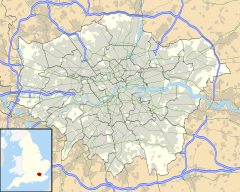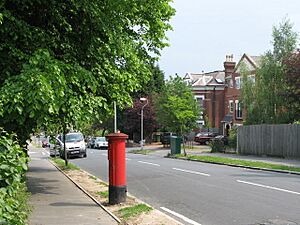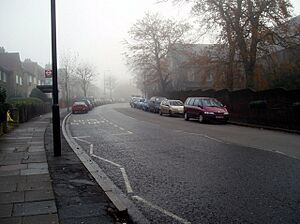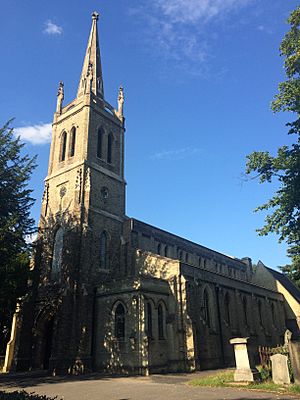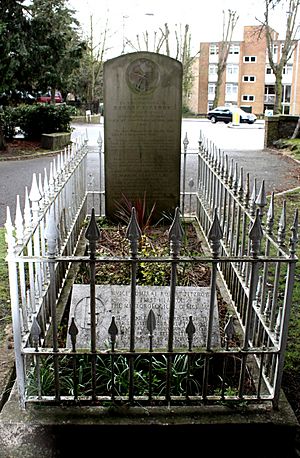Upper Norwood facts for kids
Quick facts for kids Upper Norwood |
|
|---|---|
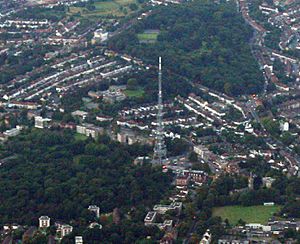 Upper Norwood from the air, with the Croydon transmitting station in the centre |
|
| Population | 16,082 (2011 Census.Ward) |
| OS grid reference | TQ329707 |
| London borough | |
| Ceremonial county | Greater London |
| Region | |
| Country | England |
| Sovereign state | United Kingdom |
| Post town | LONDON |
| Postcode district | SE19 |
| Dialling code | 020 |
| Police | Metropolitan |
| Fire | London |
| Ambulance | London |
| EU Parliament | London |
| UK Parliament |
|
| London Assembly |
|
Upper Norwood is an area in south London, England. It is split between four different London boroughs: Bromley, Croydon, Lambeth, and Southwark. Upper Norwood is located north of Croydon. The eastern part of the area is also known as Crystal Palace.
Upper Norwood sits on a hill called Beulah Hill. Most of the homes here were built in the 1800s and 1900s. You can find large houses along the top of the hill. Smaller homes are built on the slopes. There are also some newer social housing areas from the 1970s. From the hill, you can see amazing views. You can look north towards central London. To the south, you can see central Croydon and the North Downs.
Contents
History of Upper Norwood
This area is one of the highest spots in London. For hundreds of years, it was covered by a huge forest called the Great North Wood. This forest was full of oak trees. It was a wild place close to the growing city of London. The name "Norwood" actually means "North Wood."
A local story says that Sir Francis Drake's famous ship, The Golden Hind, was built using wood from this very forest! The forest was a popular place for Londoners to visit for fun. But in the 1800s, people started building homes there. The area was also a common spot for Gypsies. Many street names and pubs in the area, like Gipsy Hill, remember this connection. Even today, Upper Norwood still has a lot of woodland for a city area.
Measuring the Land
The Beulah Hill ridge was used for an important survey between 1784 and 1790. This survey, called the Anglo-French Survey (1784–1790), measured the exact distance between the Royal Greenwich Observatory in London and the Paris Observatory in France. They used a method called trigonometry. Beulah Hill was perfect for this because it was high up and close to Greenwich.
The Royal Beulah Spa
In 1831, a famous architect named Decimus Burton designed a spa and gardens here. It was called The Royal Beulah Spa and Gardens. It was built around a special spring of water. The spa became a very popular place for parties and events.
One famous event was a "Grand Scottish Fete" in 1834. It featured a tightrope walker named Pablo Fanque. He was a black circus performer who became very famous. He was even mentioned in a The Beatles song later on! The spa closed in 1856. This happened soon after The Crystal Palace opened nearby.
The Crystal Palace Connection
The Crystal Palace was a huge glass building. It was first built in Hyde Park for The Great Exhibition of 1851. It was then moved and rebuilt on Sydenham Hill in 1854. This amazing building was destroyed in a huge fire in 1936. Because of its importance, the area around it became known as Crystal Palace.
The eastern part of Upper Norwood is now also called Crystal Palace. This area is a busy shopping spot known as the 'Triangle'. The western part is called Crown Point. An older name for the central area was Norwood New Town.
Local Schools
Several schools are located in Upper Norwood:
- St Joseph's College is a Roman Catholic boys' secondary school. It opened in Upper Norwood in 1855. Older students can attend a co-ed sixth form here.
- Harris Academy Upper Norwood is a girls' school. It started as Westwood High School in 1958.
- Virgo Fidelis Convent Senior School is another Roman Catholic girls' school. It is on Central Hill and was founded in 1848. It is in an old house that once belonged to a well-known socialite, Mary Nesbitt.
Important Buildings and Parks
The Church of England church of St John the Evangelist is on Sylvan Road. It was finished in 1887. It is a great example of the work of architect John Loughborough Pearson. This red brick building is Grade II* listed, meaning it's very important. It has beautiful stone decorations inside and a stained glass window by Ninian Comper.
Upper Norwood Library is on Westow Hill. It is the only independent public library in the UK. It was built in 1899. The library has a special collection about the history of Upper Norwood and Crystal Palace.
A notable park here is Upper Norwood Recreation Ground. It covers about 19 acres. A hidden river of London, the River Effra, flows underneath the park.
The Croydon Transmitter is a TV tower on the hill in Upper Norwood. Another, even larger TV tower, the Crystal Palace Transmitter, is in Crystal Palace Park. These towers make the area easy to spot from anywhere in London.
Famous Events
In March 1966, just before the World Cup, the Jules Rimet trophy was stolen. It was found seven days later in Beulah Hill by a dog named "Pickles". This story made national news!
In 1985, a Safeway supermarket opened on Westow Street. This store was later bought by Morrisons in 2004 and then by Sainsbury's in 2006.
Transport in Upper Norwood
It is hard to build railways through Upper Norwood because the land is very hilly. The old Crystal Palace High Level railway station closed in 1954. The current Crystal Palace railway station is quite a distance below Upper Norwood. You have to walk down many steps to reach it.
However, Crystal Palace Parade is a busy place for buses. Many people use local bus routes to get to other train stations like West Norwood, Tulse Hill, Streatham, West Dulwich, or Norbury railway station. Because it's not directly connected to the main train or tube network, house prices here can be lower than in other areas with great views of London.
Nearby Places
- Anerley
- Croydon
- Crystal Palace
- Dulwich
- Elmers End
- Gipsy Hill
- Penge
- South Norwood
- Sydenham
- West Norwood
- Thornton Heath
Nearest Stations
- Crystal Palace railway station (East London Line services from 2010)
- Gipsy Hill railway station
- West Norwood railway station
Notable People from Upper Norwood
Many interesting people have lived in Upper Norwood:
- Ira Aldridge (1807–1867) was an American and British actor. He lived on Hamlet Road. A blue plaque marks his home.
- Thomas Attwood (1765–1838) was a composer and organist. He hosted the famous composer Felix Mendelssohn here.
- Raymond Chandler (1888–1959) was a famous author of detective novels. He lived in Auckland Road as a boy. His house also has a blue plaque.
- Sir John Ninian Comper (1864–1960) was a great architect. His son, Nicholas Comper (1897–1939), designed an airplane in their garden!
- Edward Elgar (1857–1934), a famous composer, lived here with his wife in 1889.
- Robert FitzRoy (1805–1865) was the captain of HMS Beagle and invented the weather forecast. He is buried in front of All Saints' Church.
- Benjamin Waterhouse Hawkins (1807-1894) was the sculptor who created the famous Crystal Palace Dinosaurs in the park.
- Joseph Paxton (1803-1865) was the brilliant designer of the Crystal Palace.
- Camille Pissarro (1830-1903), the famous Impressionist painter, moved here with his family during a war.
- Charles Spurgeon (1834–1892) was a very influential preacher. He lived on Beulah Hill. A road is named after him.
- Charlotte Carmichael Stopes (1840–1929) was a suffragette and scholar. She organized cultural groups in Upper Norwood.
- Émile Zola (1840–1902), a French novelist, lived here in exile for a time.
See also
 In Spanish: Upper Norwood para niños
In Spanish: Upper Norwood para niños


